And then there's evaporation. The evap rate for western Sierra lakes & ponds is commonly a 1/2" per day. Nutshell: Sierra summers are basically 3 months of relentless heat that bakes the land, strips away all moisture, and leaves the creeks & ponds dry, the grasses gray, and the clay-rich soil like terracotta tile (tip: don't ever dig in summertime). I.e., it's dry, dryer, driest.
But, even under these harsh yearly drought conditions, native flora finds a way to thrive in the open, sun-bleached fields. In our slice of the Sierra, the summer full-sun flora are mostly of the Sunflower family, Asteraceae (not a shocker), and include Rosinweed, Madia, Lessingia, Gumplant, Goldenrod, Yarrow, Yampah and a few Everlastings.
But the culmination - the crescendo - happens right around Labor Day - as an explosion of canary yellow signals the peak bloom of the Tehachapi Tarweed, Holocarpha heermannii, and thus the impending and inevitable end o' summer.
Yep, every year, in early September, this little yellow charmer hits its stride and carpets the fields, hills & dales with a bright lemony glow that a great friend described perfectly: "it makes you feel like you're standing on a giant smiley face."
A smiley face that's thinking "what a nice summer that was," I might add.
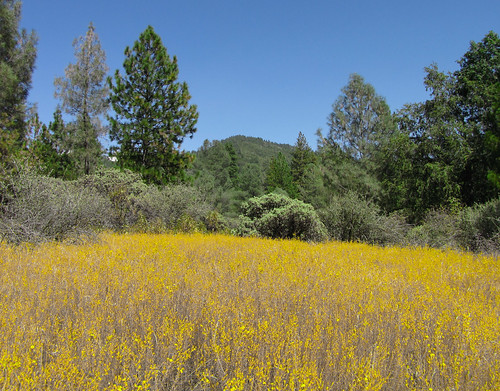
Full bloom of Tehachapi Tarweed, Holocarpha heermannii
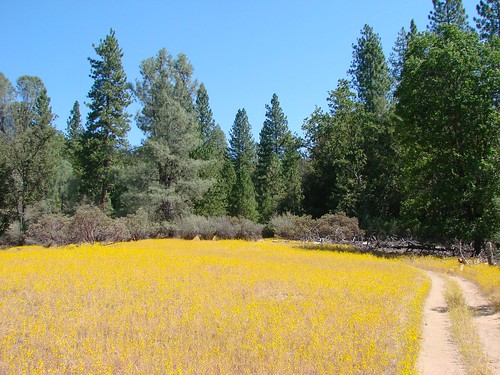
More full bloom - that's just a trail (not the curve of the smiley face's mouth!)
Holocarpha heermannii, also called Heermann's Tarweed, is named in tribute to the 1850s naturalist Adolphus "Dolly" Heermann, who made multiple collecting trips to California, and who, tragically and accidentally (and a tad ironically), shot and extincted himself at the young age of 38 while cleaning his rifle (naturalists of that time often shot anything & everything they didn't recognize to collect as a possible new species).
Tehachapi Tarweed is endemic & unique to California (and thus well adapted to it), but that doesn't seem to get it a lot of love. Domestic animals don't care for it, so Ranchers don't either (and often whack it or eradicate it). It's very sticky - the plant produces a resin that helps protect it from the harsh conditions, but it also sticks to passerbys, such as cattle, deer, coyotes, bobcats and hikers, so even some Rangers I've met don't like it much. One wander through a field and you understand - you come out covered heel-to-knee with sticky, yellow, pollen-flecked clots, that also includes any stickers, burrs and bugs that got in the way, along the way. Not a fun clean-up - especially if you happen to be wearing shorts and have hairy legs. (tip: don't use duct tape!)
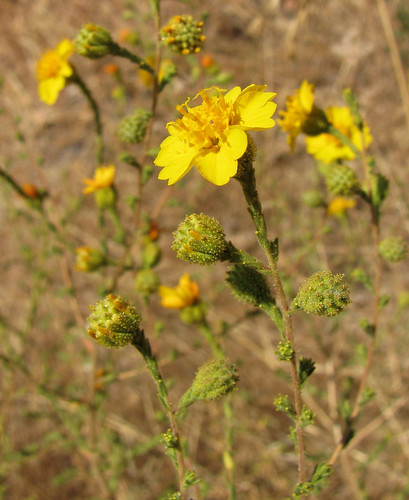
Tehachapi Tarweed - note the sticky resin oozing out of the glands,
and the compound flowers with multiple disc flowers and ray
flowers (petals), the latter with 3 teeth each
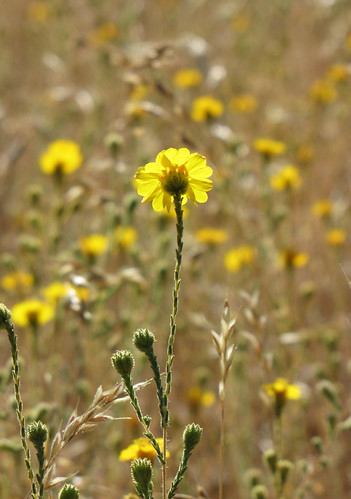
Tehachapi Tarweed has a flower the size of a penny (3/4 inch (10mm)
diameter), and typically stands 10-20 inches (25cm-50cm) tall

Peak bloom in the western foothills is the first week of September,
but Tehachapi Tarweed starts blooming in mid August and
finishes in October - a roughly 6 week cycle
Some might not care for the gumminess, but the resin does give Tehachapi Tarweed a wonderful aroma (IMO). Very sage-like, with a slight hot-asphalt edge, and a power & pungency that carries well. I.e., you don't have to bend over to smell these fragrants - they broadcast their scent like it's everybody's business.
While I can't convey the sticky or smelly over the web (no html tags for that yet), here's more visual beauty of the Tarweed that pops up near Mariposa, California:

Just starting to bloom in mid-August

Mixed with an old snag
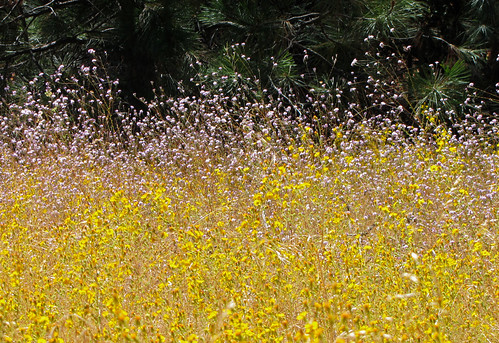
Tarweed and Lessingia together

Tarweed and Ponderosa Pines
Ah, the yellowfields of September in the Sierra Nevada. A seasonal California floral event that's definitely worth seeing & smelling at least once (but maybe not touching).
====
Here's a couple of other "tarweeds" (resin producers) of the Tribe Madieae, in the Family Asteraceae, that also bloom at 3,000 feet in the western Sierra Nevada - Rosinweed, Calycadenia mollis, and Common Madia, Madia elegans (which is anything but common):
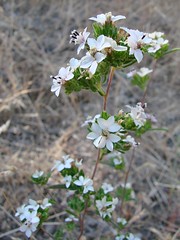
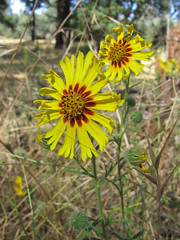
Rosinweed & Madia
And a lovely, but not-so-smelly white Tarweed, Hemizonia congesta, that grows near the coasts in California (but unfortunately not with enough density to create white blankets):
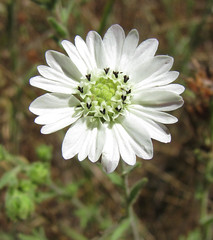
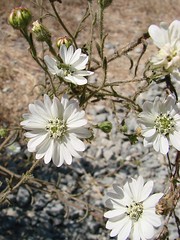
Bathing cap beauties - Hayfield Tarweed
And, finally, a smattering of other native Summer-blooming Asteraceae of the Sierra Nevada - note the common Asteraceae feature of many "petals" and compound flowers:

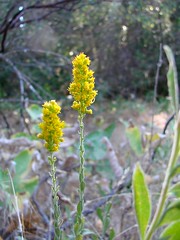
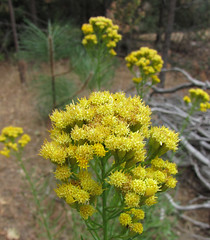



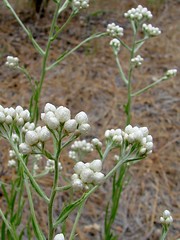
In order of appearance: Lessingia, California Goldenrod, Golden Fleece, Everlasting Cudweed, Gumplant, Yarrow, and Pearly Everlasting.
====
References:
- Wikipedia - Holocarpha heermannii
- Wikipedia - Madieae
- Wikipedia - Asteraceae
- Calflora.org - Holocarpha
- Tehachapi News - Tehachapi Tarweed: sticky, fragrant and historic
- eFloras.org - Holocarpha

Another great, detailed post! And very sensory too - sight, smell and touch. Too bad about Heerman. I guess it's good to be limited to binos and cameras. It's hard (but not impossible) to do self-damage with those. I like especially the picture featuring the ponderosa pines.
ReplyDeleteThanks much Hugh. I do like the details... :) Might have to write more about Heermann and the gun-toting collectionists of his time. They were interesting characters. That pic of the pondy pines & tarweed is a fave of mine too - it's from 2008 cause I never saw it as pretty during this year's bloom.
ReplyDeleteA very nice reference for Sierra lovers, too. I never realized how much I missed the smell of summer tarweed until I came back to California. Apparently it's also a host plant of grass katydids of the genus Clinopleura. My buddy Mr Smiley of the blog Bunyipco believes that collecting in the stuff will uncover some new species.
ReplyDeleteThanks Codger. Always nice to hear from a fellow tarweed fan. That's interesting info about the katydids - I'll have to watch for them. A variety of bugs do love it and live in it. I follow Bunyipco too - maybe I'll have to see if he has any ideas on how to collect in it. I'm going to be trying my first bug sheet soon and it was inspired by him!
ReplyDeleteI was looking up tarweed on Google to make sure that it wasn't just a name that my friends and I made up as kids. Seeing this beautiful page made me stop and read. Though I'm now on the central coast, I grew up in the Sierra foothills, and miss smelling the tarweed at night when we'd open all the windows to cool the house. I also loved seeing the other flowers, and reading about the other things that were so very normal to a kid growing up in that area. (We had that red dirt/clay that never came out of clothes and was hard as rock in the summer) Thank you for sharing.
ReplyDeleteGlad you enjoyed the way back, Ann. I too live near the coast south of SF and miss the aroma of Tehachapi Tarweed. The locals just don't have the same bite. Which is why I have a pot of Teh Tarweed growing in my backyard. And it's in full bloom and smelliness right now. :) Next time you're in the Sierra, collect a few seeds.
Delete